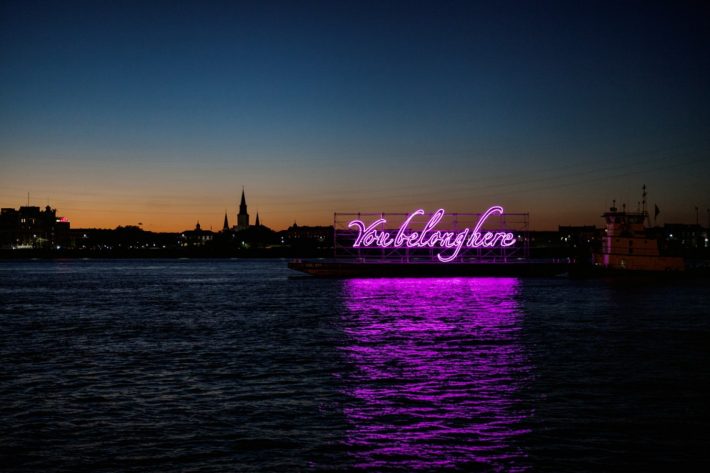By Mark Guarino via washingtonpost.com

Tavares Strachan’s sculpture “You Belong Here” floats on the Mississippi River near the French Quarter, part of Prospect 3, the international art biennial in New Orleans, through Jan. 25. (Joseph Grey/Courtesy of Prospect New Orleans)
For artists, a casual stroll through most any New Orleans neighborhood is a lesson in habitual beauty: the ethereal mid-afternoon light, the sprawl of vegetation, the bright colors of the homes, even the elegance of decayed wood.
“Almost half my practice is walking around and looking,” says Sophie Lvoff, a 28-year-old photographer who moved to New Orleans in 2009 from New York. “There’s always an underlying question of mysticism here in the everyday.”
New Orleans has long been an artistic hotbed — one that even Hurricane Katrina’s floodwaters could not extinguish. Case in point: Prospect New Orleans, an international art biennial that uses the entire city as a backdrop for work by more than four dozen contemporary artists. The free art exhibition, now in its fourth year, runs through Jan. 25.
Prospect New Orleans may not have the brand recognition of, say, the New Orleans Jazz and Heritage Festival, but organizers are optimistic that it will become just as relevant on the city’s cultural calendar.
“That is the road they are on, and it’s a totally great and achievable aspiration,” says Brooke Davis Anderson, Prospect’s executive director.
There are 180 art biennials around the world; the most well-known in the United States is the Whitney in New York, which helped launch the careers of Georgia O’Keeffe, Jackson Pollock, Jasper Johns and Robert Mapplethorpe. Also prominent are the Carnegie International in Pittsburgh and SITE Santa Fe in New Mexico.
The idea for a similar global event in New Orleans came from Dan Cameron, an East Coast curator who saw Prospect 1, in 2008, as a chance to showcase New Orleans in recovery, three years after Katrina. More than 80 artists took part, and thousands of people showed up, many out-of-towners. Suddenly, New Orleans was at the center of avant-garde art.
The first Prospect was “mind-boggling,” says longtime New Orleans gallery owner Arthur Roger.
“The city was just so raw, and the artists responded in an extraordinary way,” he says. “But it wasn’t about the local art scene; it was about the city and the artists responding to the city at the time.”
Despite the welcome attention on the city, however, some local artists felt Prospect was overly focused on outsiders. Cameron stepped down after Prospect 2, which was less successful (an event called Prospect 1.5 focused only on local artists, which seemed to some like low-budget segregation).
This year’s organizers say that they are striving to be more inclusive of the city they hope to call home for many years and that local artists will have a more prominent role (eight New Orleans artists are on the roster).
“The idea of saying we’re doing a local biennial and a global biennial does not seem like the right way to celebrate New Orleans art and culture,” Anderson says. “The outside world is most interested in an international biennial, so why would we not feature New Orleans artists, because what is happening in New Orleans is exciting, sophisticated, smart, provocative and challenging and stands up to anything that is happening elsewhere.”
Prospect 3 also is more manageable than its predecessors, with fewer artists and, at a cost of $2.5 million, half the budget. And this time around, it’s free, which organizers hope will attract more local residents. The theme, too — loosely based on the 1961 New Orleans-set novel “The Moviegoer,” by Walker Percy — is a nod to the city.
Lvoff, one of the local artists being featured at this year’s Prospect, says she worked with curator Franklin Sirmans to create work that played off the novel’s idea of transcending the ordinary. “It’s not a direct illustration of the book, but I use it as a jumping-off point,” the photographer says.
For some prominent local artists, who have been inspired by New Orleans for decades, the art show contributes to the rebirth of their city — one beyond Mardi Gras and the tourists on Bourbon Street.
“Prospect has introduced some thought-provoking international contemporary art to Louisiana that otherwise may not have been experienced,” says local painter and illustrator Jacqueline Bishop, who has exhibited at Roger’s gallery. “It has introduced another dimension of New Orleans to a wider audience. This is the beauty of how things organically grow down here.”
Guarino is a freelance writer.
Prospect New Orleans Through Jan. 25. www.prospectneworleans.org.
